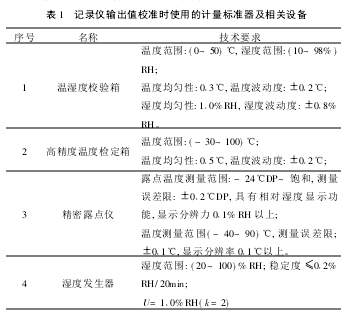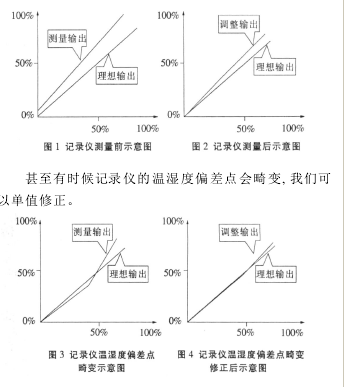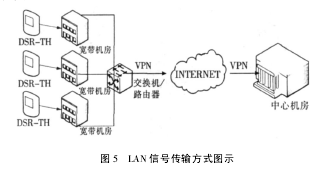In today's increasingly important environmental monitoring, temperature and humidity recorders are mainly used in monitoring and control of temperature and humidity in industrial environments, scientific experiments, inspection and inspection, medical and health, warehousing, agricultural cultivation, breeding seedlings, and device warehouses. In order to achieve the relevant operating environment conditions can meet the relevant requirements to ensure that the production process and process, product quality meet the relevant requirements and the experimental results are accurate and reliable. The traditional mechanical temperature and humidity recorder has low accuracy and low sensitivity. In addition, the use of a paper transport recorder requires a large amount of recording paper, and it is troublesome to read historical data.
The digital signal temperature and humidity recorder is a new low-power digital instrument integrating the analog signal acquisition, display, storage and analysis. It shows intuitive, high sensitivity, no need to record paper and other consumables, no manual reading, that is, when the watch can also be used as a recorder. Stored data can easily export charts, EXCEL files, and text files for easy archiving. The long record time and powerful analysis software are beyond the reach of traditional meters. Digital signal temperature and humidity recorder temperature measurement range is generally (-30 ~ 70) e, humidity measurement range is generally (0 ~ 100)% RH. Some recorders can also accurately calculate the dew point to meet the needs of some high-end users.
1 The main structure and basic working principle Digital signal temperature and humidity recorder (hereinafter referred to as the recorder) is mainly composed of temperature sensors, humidity sensors, indicating instruments, digital circuits, storage units and serial port communications. The temperature-sensitive sensor mainly adopts a platinum thermal resistor or a semiconductor thermistor, and the humidity sensor mainly uses a resistive humidity sensor, a capacitive humidity sensor or a moisture sensitive resonator element manufactured by a polymer film and various inorganic compound crystals. The hygroscopic substance used in the manufacture of the humidity sensor must also meet the basic condition that the humidity capacitance (or resistance) characteristic is reversible and has good repeatability. At the same time, the output signal is a single-valued linear function of relative humidity and temperature in the measured environment.
The basic working principle of the recorder is as follows: The analog circuit provided by the peripheral sensor is converted into a digital circuit through AD conversion, and then the later-stage data processing and adjustment are performed by a common single-chip microcomputer technology. The general temperature and humidity recorder has an indicating meter for displaying. The current temperature and humidity values, but a small number of recorders have no display, can only be read through communication with the computer serial port. The storage unit of the recorder generally uses rewritable EEPROM. Due to the different size of the storage unit, the number of stored data can range from 5,000 groups to 50,000 groups, and the recording interval is from 2 seconds to 2 hours, thus the storage time recording room Short is only a few dozen days, long can reach several years, even more than ten years, of course, these are also affected by the length of battery life. Each recorder has its own software to read the value, time curve, including the late printing, some also have a variety of alarm forms: sound and light alarm, SMS alarm, mail alarm, telephone alarm and so on.

2 Recorder temperature and humidity deviation calibration
2.11 Selection of calibration standards and related equipment for calibration Select a high-precision temperature and humidity calibration box or humidity generator as a constant temperature source and humidity source for the calibration of the recorder. Use a precision dew point meter as a measurement standard to measure temperature respectively. Humidity check box or humidity generator's actual temperature and humidity values ​​and recorder's display value. In order to ensure the accuracy and reliability of the calibration results of the temperature and humidity recorders, it is necessary to ensure that the calibration standards used in calibration and related equipment meet the technical requirements shown in Table 1.
2.12 Calibration method First connect the recorder to the host computer through the serial port (or USB) and set it through the corresponding software. The time interval between recording or refreshing should be as short as possible, for example, 10 seconds/time, then select the storage mode. The general data is First-in, first-out, full-stop recording, full-coverage coverage, and first-in, first-out selection, and other parameters can be set according to their own needs to reset the recorder. The sensors of the recorder and the precision dew point meter are then placed in a high-precision temperature and humidity check box or humidity generator. The dew point sensor should be as close as possible to the recorder's temperature and humidity sensors.
2.13 Recorder humidity, temperature measurement part of the calibration at a temperature of 20e, the recorder humidity measurement part of the performance of the calibration, calibration humidity point can be selected as 20% RH, 40% RH, 60% RH, 80% RH or 30% RH, 50% RH, 70% RH, 90% RH. The humidity value of the humidity and humidity calibration box or the humidity generator is controlled in the order of 0/l wet 0 or/and low humidity 0. When the humidity of the check box or generator reaches the calibrated humidity point and is stable, the precision dew point measuring instrument is read separately. Humidity measurement and recorder humidity display values.

The humidity calibration box or generator humidity value of 40% RH, the recorder temperature measurement part of the performance of calibration, calibration humidity points can be selected as 10e, 20e, 30e, 40e. The temperature value of the temperature and humidity calibration box or generator is controlled in the order of 0 or 0 or 0, or 0, and/or 0. The temperature of the precision dew point meter is read separately when the humidity of the box or generator reaches a calibrated temperature point and is stable. The value and temperature of the recorder display. The basic error of the temperature and humidity recorder is calculated according to equation (1): $X = Xi - (X0 + Xe) (1) where: $X) The temperature and humidity recorder shows the basic error of the value at each calibration point. e or %RH;Xi) Display value of temperature and humidity recorder at each calibration point, e or %RH; X0) Display value of standard instrument at each calibration point, e or %RH; Xe) at each At the calibration point, the standard instrument shows the correction of the value, e or %RH. Take the value of the absolute value of the basic error at each calibration point as the maximum basic error value on the temperature and humidity recorder, and compare it with the allowable basic error value of the temperature and humidity recorder and determine.
3 correction of the recorder temperature and humidity deviation Because the humidity sensor can not be sealed protection, its measurement part is always in contact with the dust and chemicals in the air, so that the sensor drifts in some environments. At the same time, the electrical part of the instrument will change due to the passage of time, temperature changes, and mechanical vibrations, so there is usually such a phenomenon that the recorder uses a period of time after the measured data deviates from the actual data, so for most temperature and humidity recorders The working status must be checked regularly, and the temperature and humidity deviations should be corrected to ensure that the performance and accuracy of the instrument meet the requirements.
At present, various manufacturers of temperature and humidity recorder sensor output a variety of signals; voltage, capacitance, resistance, frequency, etc., but through a variety of output signals corresponding to a set of AD values. In fact, we correct this AD value to get more accurate measurements. For common temperature and humidity deviations, we can linearly correct. Theoretically, the deviation of temperature and humidity is linear, but after experiments, this is not the case. As shown in Figure 1,2.
4 Application of modern engineering network With the continuous improvement of modern enterprises in manufacturing, warehouse management, process control, etc., and the implementation of ISO standards and GMP medical standards, the temperature and humidity display, recording, management, and control have become increasingly important. Practical significance. In the production of integrated circuits, testing, SMT processing, and material preservation, the requirements for temperature and humidity of electronic factories are relatively high, because these parameters will seriously affect the quality of components and the quality of production. To ensure a stable temperature and humidity environment and obtain historical data, it is the best quality control method and event analysis mechanism for such enterprises.

In the era of rapid data growth, the number of various server rooms, data rooms, and mobile base stations has increased dramatically. At the same time, this kind of computer room is in high demand for the environment during operation, abnormal temperature, humidity will cause the machine to crash and other failures, and bring unnecessary losses to the enterprise. Therefore, it is very important and necessary to have a complete temperature and humidity monitoring device. For the above-mentioned many objects to be monitored and widely distributed, the monitoring method using multi-machine industrial bus networking can be used. Wired networking can be divided into RS485/RS232, wireless through WIFI networking, in theory there is no limit on the number of access points, but there is a distance limit, network monitoring parameters can be incorporated into the network management system, can also be displayed on the large screen at the same time . With the popularization of broadband access and the development of multimedia data services such as VOD, metropolitan small-scale computer rooms and wireless base stations are increasingly distributed in cities. Due to the large number and wide distribution, the operating environment cannot be monitored in time, and the server is often down or malfunctioning due to environmental factors. The superior networking technology of the temperature and humidity recorder can be connected to the backbone network or VPN through the switch/router; it is very convenient to access the telecommunication service network and cluster monitoring becomes a reality.
Other industries need to record temperature and humidity in the environment because they are distributed in harsh environments, or need to be monitored. For example, drug storage in the medical industry, blood serum transportation, preservation of chemical reagents, weather stations in the field, small weather stations, etc. Control in a constant temperature and humidity, or real-time collection of data transmission, and these data on the final use and medical accident identification or weather forecast are all necessary facts. It must be connected in a wireless manner. It can quickly access the central computer room through the GPRS network and the host. When the environment is abnormal, it can also send information to the network management mobile phone in a timely manner, which is very convenient for the rapid response of the monitored object when an emergency occurs. .
Related Recommendations: Small Weather Stations
China 42mm Split Set Stabilizer,Friction Bolt,Split Set Bolt supplier & manufacturer, offer low price, high quality Mining Bolt,Split Set Rock Bolts, etc.
42mm Split set bolt is also called "split set stabilizer". It was successfully developed by American Professor Scott in the early 1970s. It was used as a patented product by Ingersoll Rand for mining support. In the early 1980s, the Beijing Institute of Well Construction conducted exploratory tests on slotted pipe anchors in the laboratory and achieved good results. Later, it was gradually promoted and applied in the coal system.
42mm Split set bolt is a underground mining support product. It has simple installation process and convenient use. It has strong anchoring force and tensile strength in underground mining and shotcrete support. It has Large force, strong expansion force.
42mm Split set bolt has good supporting effect. Bolt support conforms to modern rock mechanics and surrounding rock control theory in terms of support principles, and belongs to active support. After the bolt is installed, the stability of the surrounding rock can be mobilized and utilized, and the bearing capacity of the surrounding rock can be fully utilized, and controls the deformation of the surrounding rock of the roadway effectively.so split set bolt can protect the stability of the surrounding rock of the roadway and improve the maintenance of the roadway.
42Mm Split Set Stabilizer,Underground Anchor Rod,Pipe Joint Anchor,Rock Friction Bolt
anto mining equipment co.,Ltd , https://www.antobolts.com